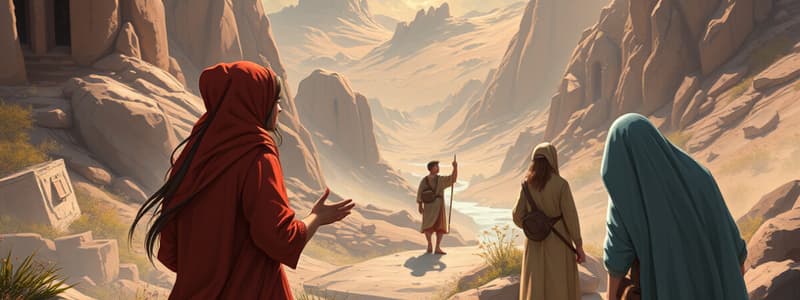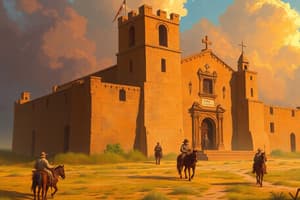Podcast
Questions and Answers
What did the Haystack Prayer Meeting represent?
What did the Haystack Prayer Meeting represent?
- Non-Western dominance
- European dominance (correct)
- American dominance
- Student involvement in missions
What is the primary characteristic of God according to the Enterprise for Missions?
What is the primary characteristic of God according to the Enterprise for Missions?
- God is vengeful
- God is indifferent
- God is universal (correct)
- God is strict
What does the table of nations signify in the context of missions?
What does the table of nations signify in the context of missions?
It showcases the diversity of nations and their connection to God's mission.
Which of the following is NOT a geographic focus of the mission eras?
Which of the following is NOT a geographic focus of the mission eras?
Match the leaders with their corresponding years of influence in missions.
Match the leaders with their corresponding years of influence in missions.
What is a people movement in missions?
What is a people movement in missions?
What does a mission station aim to do?
What does a mission station aim to do?
The P-Scale represents the cultural distance of the people group from the church, with P0 being ___ .
The P-Scale represents the cultural distance of the people group from the church, with P0 being ___ .
The E-Scale defines the evangelist's cultural distance from potential converts, with E0 representing ___ .
The E-Scale defines the evangelist's cultural distance from potential converts, with E0 representing ___ .
What was a key issue during the confusion between missionary eras?
What was a key issue during the confusion between missionary eras?
What is the first stage of missions according to the stages of missions?
What is the first stage of missions according to the stages of missions?
What was the sequence of missionary expansion?
What was the sequence of missionary expansion?
What did Robert DeNobili do to reach the Brahman?
What did Robert DeNobili do to reach the Brahman?
What is accomplished through suffering and martyrdom?
What is accomplished through suffering and martyrdom?
What does the 'Wall' represent?
What does the 'Wall' represent?
What is a witness in the context of missions?
What is a witness in the context of missions?
Should Gentiles become culturally Jewish to become believers?
Should Gentiles become culturally Jewish to become believers?
Flashcards are hidden until you start studying
Study Notes
Mission Eras - Student Involvement & Sending Base
- Haystack Prayer Meeting symbolizes European dominance in early missions.
- The Student Volunteer Movement indicates the rise of American influence in mission efforts.
- The Student Foreign Mission Fellowship marks the shift towards non-Western leadership in missions.
Enterprise for Missions
- God is universal; creation reflects His desire to engage with all humanity.
- God's loving character seeks for everyone to know Him and not perish.
- The Abrahamic covenant underscores the promise to bless all nations through Israel.
- The Holy Spirit empowers witnesses and convicts the world of sin.
- The Church consists of diverse ethnic groups tasked with sharing the gospel with all peoples.
Biblical Mandate for Missions
- The Table of Nations highlights the interconnectedness of people groups.
- Israel's election signifies a chosen role to bless all nations.
- The exile of Israel emphasizes its historical ties to other nations.
- Themes of rescue and liberation appear repeatedly, illustrating God’s redemptive purpose.
- The Book of Jonah exemplifies the missionary motif as a light to the nations.
- Antagonism towards Israel throughout scripture reflects broader mission tensions.
Mission Eras - Geographic Focus
- Historical attention focused on the coastlands of Africa and Asia.
- The mission efforts expanded inland to reach more remote areas.
- Unreached people groups still represent a significant focus of current missions.
Eras of Missions - Key Leaders
- William Carey led missionary efforts from 1792-1910, pioneering modern missions.
- Hudson Taylor's influence spanned from 1865-1980, significant for his work in China.
- Cam Townsend and Donald McGavran were influential post-1934 in shaping missions strategies.
People Movement
- Encourages converts to remain within their communities, facilitating rapid gospel sharing through existing social networks.
Mission Station
- This approach aimed to integrate converts into new communities but often minimized the spread of the gospel.
P - Scale
- A scale measuring cultural distance from the church, with:
- P0: culturally relevant church presence
- P1: local church present but culturally irrelevant
- P2: no church, culture similar to another group with a church
- P3: no church, culturally distinct from nearby church groups.
E - Scale
- Defines the evangelist's cultural distance from potential converts:
- E0: believers within the church
- E1: culturally similar outsiders
- E2: outsiders with a similar culture
- E3: externally distinct culture.
Confusion Between Missionary Eras
- Missionaries faced tension between staying to saturate existing locations and expanding to unreached areas.
- Early eras focused on coastal regions but later recognized the need for inland outreach and reaching new peoples.
Stages of Missions
- Pioneer stage: primarily led by missionaries.
- Parent stage: missionaries train local nationals.
- Partner stage: establishes equal relationships.
- Participant stage: missionaries step back and assist upon invitation.
Order of Missionary Expansion
- Initial efforts began in Rome.
- Subsequent waves included the Barbarians, Vikings, and Saracens.
- The mission ultimately aimed to reach the ends of the earth.
Robert DeNobili
- Adapted to Brahman culture for better engagement, exemplifying contextualization in missions.
Accomplishments Through Suffering and Martyrdom
- Martyrdom can triumphantly display God's truth; believers meeting death joyfully can lead others to faith.
- It represents a defeat of fear, showcasing Satan's loss of control over believers.
- God is glorified through self-sacrifice, reflecting Christ’s sacrifice for humanity.
Wall and Canyon
- The "Wall" symbolizes barriers to communication.
- The "Canyon" represents barriers to gospel acceptance, highlighting the need to engage cultures without alienation.
Definition of a Witness
- Being a witness encompasses more than stating facts; it involves obedience and readiness to publicly share faith even at personal risk.
Issue of Acts 15
- Clarified that Gentiles do not need to adopt Jewish cultural practices to become believers.
Studying That Suits You
Use AI to generate personalized quizzes and flashcards to suit your learning preferences.




